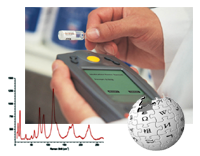February 01, 2007
WikiRaman
 This week on CNE Health I talked about ways of detecting fake drugs, in particular the exciting possibility of using spatially offset Raman spectroscopy to peek inside transparent packaging and check that the chemical spectrum really corresponds to what the drug is supposed to be.
This week on CNE Health I talked about ways of detecting fake drugs, in particular the exciting possibility of using spatially offset Raman spectroscopy to peek inside transparent packaging and check that the chemical spectrum really corresponds to what the drug is supposed to be.
While such a system is obviously useful for centralized checkpoints in the supply chain and random inspections by authorities, it is even more interesting if customers, pharmacists and other people can easily get their hands on cheap portable screening devices. It would enable far more fake detection as well as a way of quality control.
What would be needed is a public database of Raman spectra for every drug, which doesn't sound too hard to make. If producers and governments won't supply it I don't see any problem in making a WikiRaman (or perhaps WikiSpectrum) site where people simply scan their drugs and upload the spectrum to the site. This way we could get a sense of variability too. If a RFID or barcode reader is included we would have a efficient way of linking stated drug names and suppliers with the spectrum too.
This works not just for pharmaceuticals but for other kinds of drugs too. Among illicit drug users many forms of quality control are used, but many are little more than superstition. If drug quality was easier to measure many lives would likely be saved. Ecstasy purity tests have been distributed as a harm reduction strategy. Having SORS scanners might enable wider testing (especially if the users of WikiRaman can be assured that there is no tracking of what they scan, either because the site is run independently of law enforcement, has downloaded the right spectra to an onboard library or because of anonymizing communications software asking for a dozen of "popular" spectrums).
So what we need is a cheap, portable, reliable SORS scanner that can easily upload a spectrum to a site and compare it with stored templates. RFID/EAN reader capability would be welcome too. We also need open standard formats for Raman spectra. None of this seems terribly hard to do.
Drug counterfiters might of course try to find ways to fool the scanners such as adding substances to packaging to confuse the spectrum, coating ineffective drugs with the real drug and so on. But the pressure quick and ubiquitious testing puts on them and the cost of many of these measures seem likely to bring down the practice. Again, WikiRaman and perhaps an adjoint database of shared information about observed drug qualities linked to their appearance and identifications would help a lot (some interesting challenges in designing these to resist attacks from counterfiters).
In the long run having devices able to at least identify if a substance is what it is supposed to be might be helpful far beyond drugs. It might be the second easiest way of checking whether it is sugar or salt one is adding to the cake.
Posted by Anders3 at February 1, 2007 01:09 PM